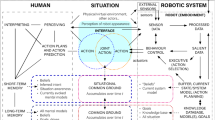Abstract
This paper re-evaluates what constitutes a social robot by analysing how a range of different forms of robot are interpreted as socially aware and communicative. Its argument juxtaposes a critical assessment of the development of humanlike and animal-like robotic companions with a consideration of human relations with machinelike robots in working teams. The paper employs a range of communication theories alongside ideas relating to anthropomorphism and zoomorphism in discussing human–robot interactions. Some traditions of communication theory offer perspectives that support the development of humanlike and animal-like social robots. However, these perspectives have been critiqued within communications scholarship as unethically closed to the possibilities of otherness and difference. This paper therefore reconfigures and extends the use of communication theory to explore how machinelike robots are interpreted by humans as social and communicative others. This involves an analysis of human relations with explosive ordnance disposal robots and with the robotic desk lamp, AUR. The paper positions social robotics research as important in understanding working teams containing humans and robots. In particular, this paper introduces the value of tempered anthropomorphism and zoomorphism as processes that support communication between humans and machinelike robots, while also ensuring that a sense of the otherness of the machine and respect for its non-human abilities is retained.
Similar content being viewed by others
References
Ackerman E (2013) Soldiers can get emotionally attached to robots, and that may not be a good thing. Spectr IEEE 12:545–552
ALAVs Autonomous Light Air Vessels (2014) http://www.alavs.com/. Accessed 20 April 2014
Asimov I (1990) Robot visions. ROC, New York
Bartneck C, Chioke R, Menges R, Deckers I (2005) Robot abuse—a limitation of the media equation. In: Proceedings of the interact 2005 workshop on abuse
Bekoff M (2007) The emotional lives of animals: a leading scientist explores animal joy, sorrow, and empathy-and why they matter. New World Library; Distributed by Pub. Group West, Novato, Calif.: [s.l.]
Breazeal C, Foerst A (1999) Schmoozing with robots: exploring the boundary of the original wireless network. In: Proceedings of the third international conference cognitive technology, pp 375–389
Breazeal CL (2002) Designing sociable robots. MIT Press, Cambridge
Capek K (2006) R. U. R. eBooks@Adelaide. The University of Adelaide Library, Adelaide
Carey J (1992) Communication as culture: essays on media and society. Routledge, New York
Carpenter J (2013) The Quiet Professional: An investigation of U.S. military explosive ordnance disposal personnel interactions with everyday field robots. PhD, University of Washington
Chang BG (1996) Deconstructing communication: representation, subject, and economies of exchange. University of Minnesota Press, Minneapolis
Clark D (1997) On being the last Kantian in Nazi Germany: dwelling with animals after Levinas. In: Ham J, Senior M (eds) Animal acts: configuring the humans in western history. Routledge, New York, pp 165–198
Craig RT (1999) Communication theory as a field. Commun Theory 9:119–161
Dautenhahn K (2013) Human–robot interaction. In: Soegaard Mads, Dam Rikke Friis (eds) The encyclopedia of human–computer interaction, 2nd edn. The Interaction Design Foundation, Aarhus
Dautenhahn K (1995) Getting to know each other–artificial social intelligence for autonomous robots. Robot Auton Syst 16:333–356. doi:10.1016/0921-8890(95)00054-2
Dautenhahn K (1998) The art of designing socially intelligent agents: science, fiction, and the human in the loop. Appl Artif Intell 12:573–617
Derrida J (2002) The animal that therefore I am (more to follow). Crit Inq 28:369–418
Diehm C (2000) Facing nature: Levinas beyond the human. Philos Today 44:51–59
Ekman P (1999) Facial expressions. In: Dalgleish T, Power T (eds) The handbook of cognition and emotion. Wiley, Chichester, pp 301–320
Finn A (2010) Developments and challenges for autonomous unmanned vehicles: a compendium. Springer, Berlin
Flynn CP (2008) Social creatures: a human and animal studies reader. Lantern Books, New York
Fong T, Nourbakhsh I, Dautenhahn K (2003) A survey of socially interactive robots. Robot Auton Syst 42:143–166
Freud S (2004) The Uncanny (1919). In: Sandner D (ed) Fantastic literature: a critical reader. Praeger, Westport, pp 74–101
Garber M (2013) Funerals for fallen robots. The Atlantic
Garreau J (2007) Bots on the ground: In the field of battle (or even above it), robots are a soldier’s best friend. Washington Post, Washington
Goffman E (1972) Interaction ritual: essays on face-to-face behaviour. Allen Lane, London
Gunkel DJ (2012) The machine question: critical perspectives on AI, robots, and ethics. MIT Press, Cambridge
Hanson Robotics Vision (2008) In: Hanson Robotics. http://hanson.robotics.com/. Accessed 18 Oct 2008
Hearne V (2000) Adam’s task: calling animals by name. Akadine Press, New York
Hoffman G (2007) Ensemble: fluency and embodiment for robots acting with humans. Ph.D., Massachusetts Institute of Technology
Husserl E (1973) Cartesian meditations: an introduction to phenomenology. Martinus Nijhoff, The Hague
Lang F, von Harbou T (1927) Metropolis. Universum Film (UFA)
Leite I, Martinho C, Paiva A (2013) Social robots for long-term interaction: a survey. Int J Soc Robot 5:291–308. doi:10.1007/s12369-013-0178-y
Levinas E (1990) The name of a dog, or natural rights. Difficult freedom. The Athlone Press, London
Levinas E (1989) Is ontology fundamental? Philos Today 33:121–129
Levinas E (1989) The other in proust. In: Hand S (ed) Levinas read. Blackwell, Oxford, pp 160–165
Levinas E (1969) Totality and infinity. Duquesne University Press, Pittsburgh
Lucas G (1977) Star wars episode IV: a new hope. Lucasfilm, Nicasio
Menzel P, D’Aluiso F (2000) Robo sapiens: evolution of a new species. MIT Press, Cambridge
Mori M (1970) The uncanny valley. Energy 7:33–35
Peters JD (1999) Speaking into the air: a history of the idea of communication. University of Chicago Press, Chicago
Pinchevski A (2005) By way of interruption: Levinas and the ethics of communication. Dusquene University Press, Pittsburgh
QinetiQ (2009) Fast, powerful and versatile, high payload robot technology. TALON, QinetiQ, Farnborough
Reeves B, Nass CI (1996) The media equation: how people treat computers, television, and new media like real people and places. CSLI Publications, Stanford
RoboKind About Us (2013) In: RoboKind Website. http://www.robokindrobots.com/. Accessed 18 Dec 2013
Roderick I (2010) Considering the fetish value of EOD robots: how robots save lives and sell war. Int J Cult Stud 13:235–253. doi:10.1177/1367877909359732
Russell JA (1994) Is there universal recognition of emotion from facial expressions? A review of the cross-cultural studies. Psychol Bull 115:102–141. doi:10.1037/0033-2909.115.1.102
Sandry E (2012) Dancing around the subject with robots: ethical communication as a “triple audiovisual reality”. Platf J Media Commun 4:79–90
Short S (2003) The measure of man?: Asimov’s Bicentennial Man, Star Trek’s Data, and being human. Extrapolation 44:209–223
Singer PW (2010) Wired for war: the robotics revolution and conflict in the twenty-first century. Penguin Books, New York
The Real Opie (2013) Soldiers are developing relationships with their battlefield robots, naming them, assigning genders, and even holding funerals when they are destroyed. In: Reddit/r/technology. http://www.reddit.com/r/technology. Accessed 18 Dec 2013
Turkle S (2005) The second self: computers and the human spirit, MIT, Press edn. MIT Press, Cambridge
Turkle S, Breazeal C, Dast O, Scassellati B (2006) First encounters with Kismet and Cog. In: Messaris P (ed) Digital Media Transformation in Human Communication. Peter Lang, New York, pp 303–330
Waldman K (2013) Are soldiers too emotionally attached to military robots?. Slate, St. Louis
Acknowledgments
The completion of this paper was made possible by the receipt of a CCI Research Fellowship in the Centre for Culture and Technology at Curtin University.
Author information
Authors and Affiliations
Corresponding author
Rights and permissions
About this article
Cite this article
Sandry, E. Re-evaluating the Form and Communication of Social Robots. Int J of Soc Robotics 7, 335–346 (2015). https://doi.org/10.1007/s12369-014-0278-3
Accepted:
Published:
Issue Date:
DOI: https://doi.org/10.1007/s12369-014-0278-3




